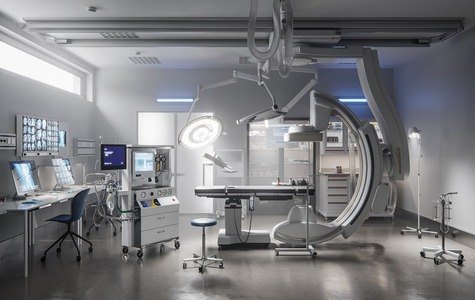- Medical Devices
- Wednesday, 29 Mar 2023
Nuclear Medicine Equipment Market (2022-2028) Business Outlook and Global Market Assessment
Nuclear Medicine Equipment Market: Key Insights
The nuclear medicine equipment market is a rapidly growing segment of the healthcare industry, driven by advances in imaging technology and an increasing demand for non-invasive diagnostic procedures. Key players in the market include GE Healthcare, Siemens Healthineers, and Koninklijke Philips N.V.
One of the major trends driving growth in the nuclear medicine equipment market is the increasing use of positron emission tomography (PET) scans. These scans provide highly detailed images of internal organs and tissues, aiding in early detection and diagnosis of cancer and other diseases.
Additionally, hybrid imaging techniques, such as PET/CT and SPECT/CT, are also on the rise, as they combine the advantages of both modalities to provide even more detailed and accurate images.
Another trend in the nuclear medicine equipment market is the growing use of targeted radionuclide therapy (TRT) for cancer treatment. TRT uses small amounts of radioactive material to target and destroy cancer cells, with minimal damage to surrounding healthy tissue. This approach is becoming increasingly popular as an alternative to more invasive treatments such as surgery and chemotherapy.
An aging population and the growing burden of chronic diseases such as cancer and cardiovascular disease drive the market for nuclear medicine equipment. As these conditions become more prevalent, there is an increasing demand for diagnostic and therapeutic procedures that can accurately and effectively manage them.
Advancement in Radiotracers to Drive Nuclear Medicine Equipment Market
Advancements in radiotracers have played a significant role in driving growth in the nuclear medicine equipment market. Radiotracers are radioactive compounds used in imaging and therapeutic procedures in nuclear medicine. They are designed to bind to specific receptors or enzymes in the body, which allows them to highlight certain organs, tissues, or diseases on a scan.
New radiotracers are being developed that have improved specificity and sensitivity, which allows for earlier detection and diagnosis of diseases such as cancer. For instance, new prostate cancer radiotracers have been developed with higher specificity and sensitivity than older tracers, leading to higher diagnostic accuracy. This can lead to earlier treatment and better outcomes for patients. New radiotracers for other diseases like Alzheimer's and Parkinson's, which were not possible to diagnose earlier, are also being developed.
The development of new radiotracers also expands the range of applications for nuclear medicine, leading to an increase in demand for nuclear medicine equipment. This drives growth in the market for nuclear medicine equipment as more hospitals and clinics looking to purchase or upgrade imaging and therapeutic equipment to offer these new procedures to patients.
Nuclear Medicine Equipment Market: Segmental Overview
The global nuclear medicine equipment market is segmented on the basis of product, application, composition, and end user. Based on product, the global nuclear medicine equipment market is segmented into single photon-emission computed tomography (SPECT), planar scintigraphy, standalone SPECT Systems, Planar Scintigraphy, and positron emission tomography (PET). The SPECT market is further segmented into hybrid SPECT systems, and standalone SPECT systems. Based on application, the market is bifurcated into oncology, cardiology, neurology, and other applications. Based on end user, the market is bifurcated into hospitals, imaging centers, and academic and research centers.
Based on end user, the hospitals segment held the substantial share in the market. The hospital segment is a significant contributor to the growth of the nuclear medicine equipment market. Nuclear medicine procedures, such as imaging and targeted radionuclide therapy, are typically performed in hospitals and clinics. As these procedures increase, hospitals are investing in nuclear medicine equipment to meet this demand. In addition, the growing focus on non-invasive diagnostic procedures and the rising prevalence of chronic diseases, such as cancer and cardiovascular disease, have increased the number of nuclear medicine departments within hospitals. This has led to an increase in the number of nuclear medicine equipment installations in hospitals, driving growth in the market. Additionally, many hospitals are upgrading their existing equipment to newer and more advanced ones to meet the changing needs of their patients and the healthcare industry.
Nuclear Medicine Equipment Market: Competitive Landscape and Key Developments
General Electric Company, Koninklijke Philips N.V., CANON MEDICAL SYSTEMS CORPORATION, Digirad Corporation, Siemens AG, Neusoft Corporation, Mediso Ltd., SurgicEye GmbH, CMR Naviscan, and Positron Corporation among the key players operating in the nuclear medicine equipment market. These companies have a widespread presence worldwide, which provides lucrative opportunities to serve a large number of customers and expand the market.
Contact Us
Contact Us: The Insight Partners
Phone: +1-646-491-9876
Email Id: sales@theinsightpartners.com
Related Industry Updates
Asia Pacific Brain Aneurysm Treatment Market Benefits & Future Investments during 2019-2027 | Stryker, Terumo, Mizuho Medical
Sep 30, 2020
Electrotherapy Systems Market is expected to reach US$ 8.57 billion by 2030
Feb 19, 2024
Asia Pacific Tunnel Sensor Market to See Massive Growth by 2027 | DURAG GROUP, ACOEM, Trolex Ltd., Safibra, s.r.o., SICK AG, CODEL International Ltd., Control Equipment Pty Ltd.
Oct 09, 2020
Cardiac Resynchronisation Therapy Market Forcasted for Excellent Revenue growth by 2027
Dec 17, 2020
Asia Pacific Medical Equipment Maintenance Market Forecast to 2027 - COVID-19 Impact and Global Analysis By Device Type (Electromedical Equipment,Endoscopic Devices,Surgical Instruments,Other Medical Equipment); By Service Provider (Original Equipment Manufacturers,Independent Service Organizations,In-House Maintenance) and Geography
Apr 09, 2021
Global Aluminum Extrusion Market Demand, Supply, Growth Factors, Latest Rising Trend & Forecast to 2027
Mar 17, 2021
Glucose Monitoring Devices Market is expected to reach US$ 39,530.75 million by 2030
Sep 18, 2023
